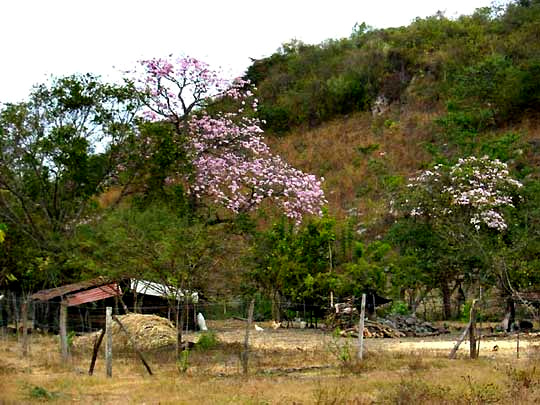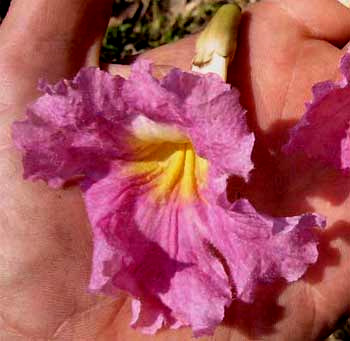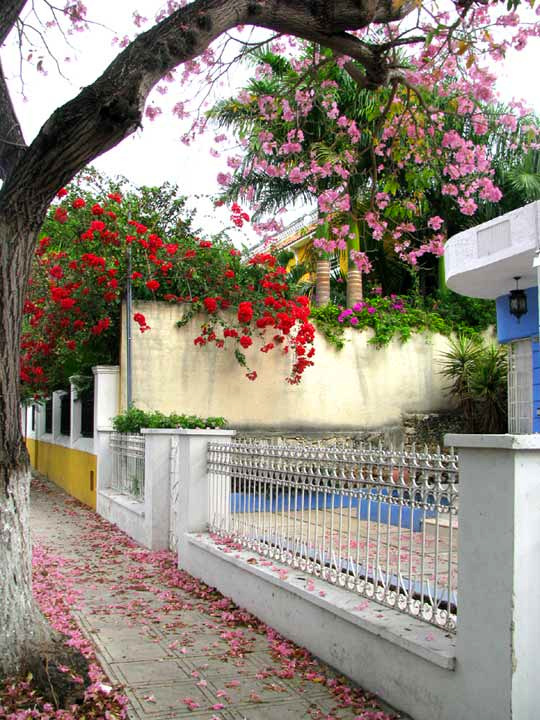Excerpts from Jim Conrad's
Naturalist Newsletter
from the February 11, 2008 Newsletter issued from Mexico's Southernmost State, CHIAPAS
PINK TABEBUIA

Sometimes a flowering tree imprints its presence on a landscape so definitively that the landscape would be a whole other thing without it. Think of the Kentucky landscape in spring without dogwoods, or Mississippi in late spring without magnolias. These days Chiapas's parched, rural landscape is ennobled with pink Tabebuias -- medium-size trees, largely leafless for the dry season, covered with pink flowers, as seen above.

I'm sort of making up that name "Pink Tabebuia," Tabebuia being its genus name, because the species is planted in many places, and it's always so admired that people give it its own local name: Pink Poui, Pink Cedar, Pink Trumpet Tree, Roble Blanco, Poirier, Poirier Rouge, Kibra Hacha, Hok'ab, Maculiz, Palo de Yugo, Roble, Palo de Rosa... On and on the names come. However, the whole world recognizes its Latin name of TABEBUIA ROSEA. It's a member of the Trumpet-Creeper Family, along with not only Trumpet Creepers but also catalpas and jacarandas.

Above you can see its trumpet-shaped flowers as well as its digitately compound leaves (leaves with leaflets arranged like digits, or fingers, on a hand). One distinctive feature of Tabebuia's leaflets is that each leaflet has its own long stem, or "petiolule." Many pink Tabebuias are completely leafless now during the dry season but others near water are fully leaved. One of the tree's frilly, yellow-eyed blossoms is shown at the left.
Antonio told me that the flowers could be eaten so I went and nibbled on a few. I found them perfumy but somewhat bitter. I guess that when the chips are down you might be glad to have them, though.
These trees are very conspicuous in towns all over tropical Mexico. Back in the Yucatán I remarked on how pretty they were along streets in Mérida. Sometimes you see them so pink beneath a deep blue sky that they look unreal, almost like too much of a good thing. But not only are they real, here they are also living well inside their original homeland, which extends from Mexico to Venezuela.
Being a native tree, it's mentioned in my Plantas Medicinales de México. A tea brewed from its bark and leaves has been used to bring down fevers.
from the April 18, 2010 Newsletter issued from Hacienda Chichen Resort beside Chichén Itzá Ruins, central Yucatán, MÉXICO
PINK TABEBUIAS AGLOW
Throughout most of the year Mérida's most audacious horticultural coloring is provided by various bright shades of bougainvillea, which I've introduced you to at www.backyardnature.net/yucatan/bougainv.htm.
That was also the case this week, though right now a native tree is just about as pretty and conspicuous with its flowering. I call it the Pink Tabebuia. It's TABEBUIA ROSEA, a member of the same family as the North's Trumpet Creeper vine and Catalpa tree. You can see a small part of a tree with its many pink flowers above and strewn on a sidewalk near the Immigration Office, with bougainvillea of two color types lavishly sprawling over a fence in the background, below:

Some complain of how the Pink Tabebuia's flowers litter areas below them. The tree's beauty when flowering far outweighs that detraction. In certain of Mérida's older neighborhoods right now the streets positively glow with the Pink Tabebuia's pinkness.